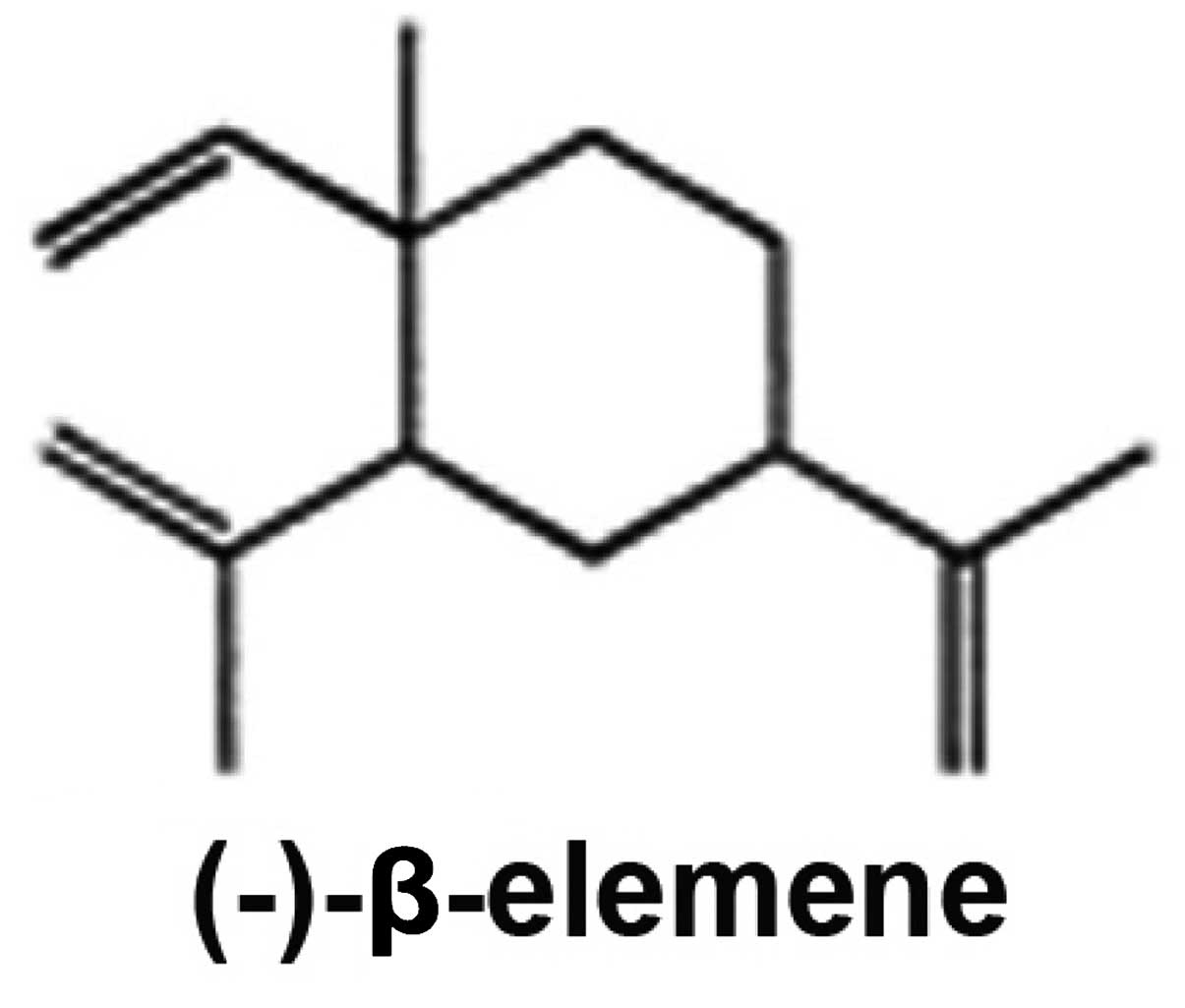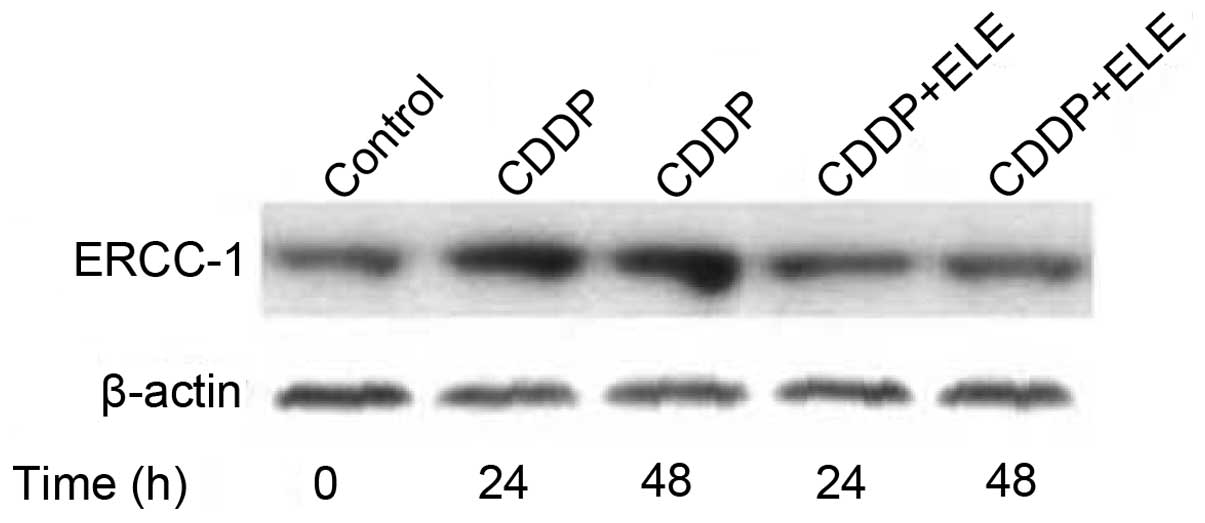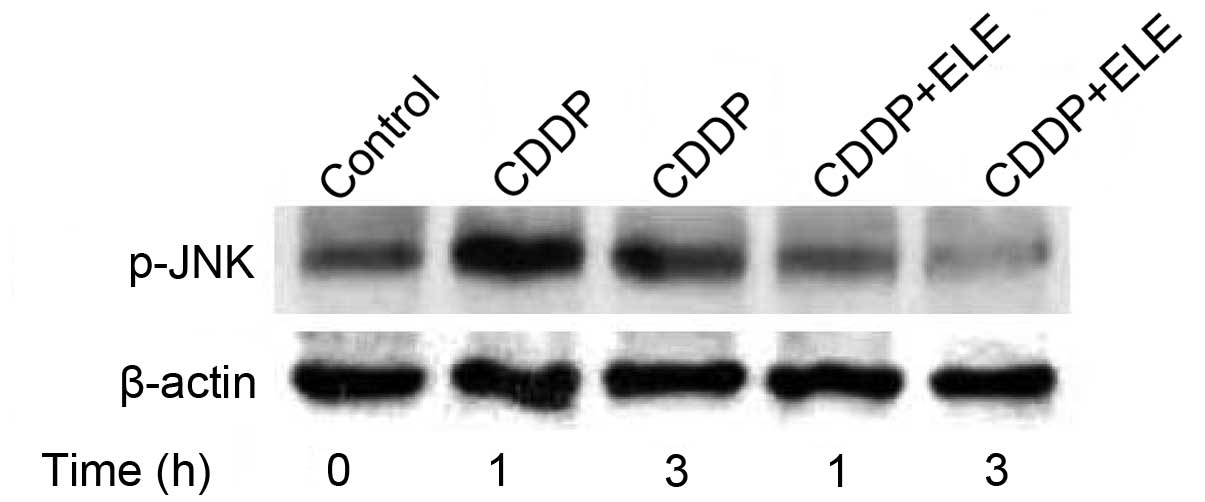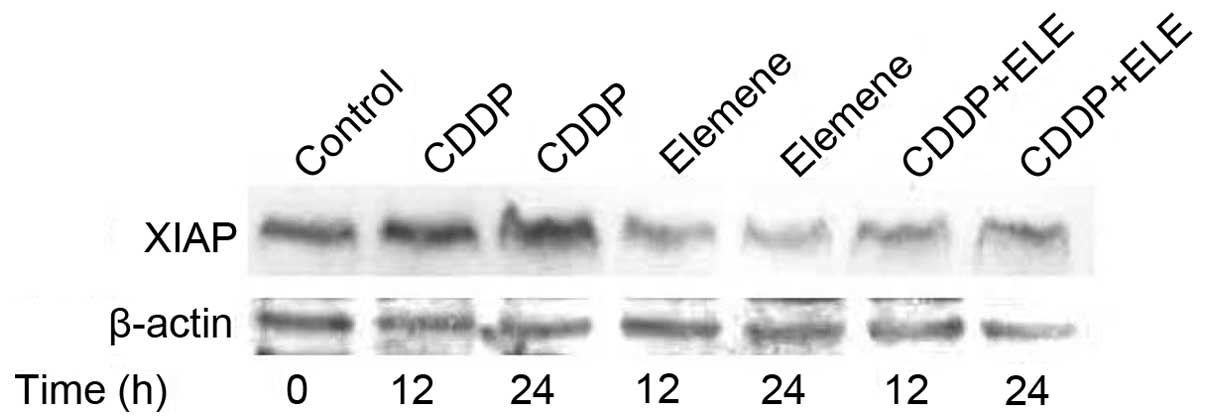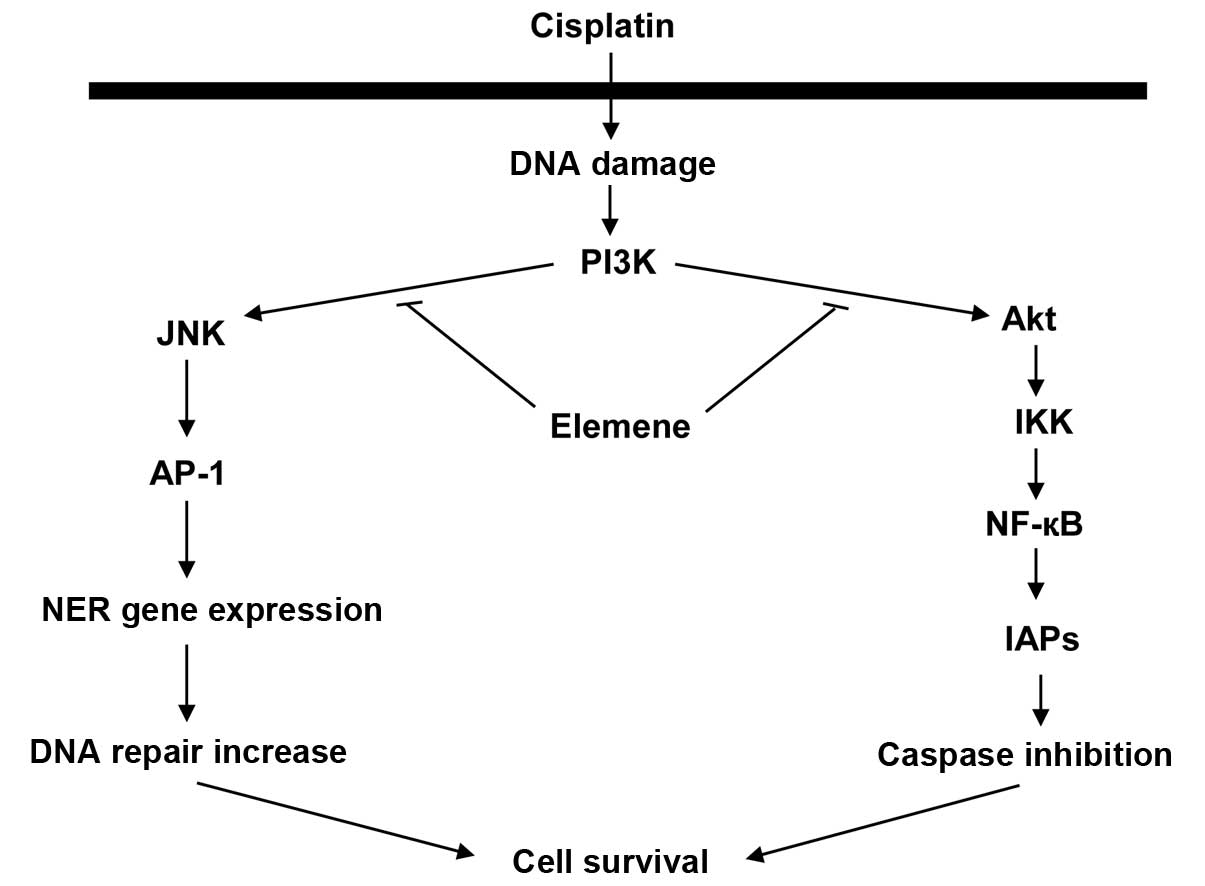|
1
|
Siegel R, Naishadham D and Jemal A: Cancer
statistics, 2013. CA Cancer J Clin. 63:11–30. 2013. View Article : Google Scholar
|
|
2
|
Reed E: Cisplatin, carboplatin, and
oxaliplatin. Cancer Chemotherapy and Biotherapy: Principles and
Practice. Chabner BA and Longo DL: 4th edition. Lippincott,
Williams and Wilkins; Philadelphia, PA: pp. 332–343. 2006
|
|
3
|
Reed E: Cisplatin and platinum analogs.
Cancer Principles and Practice of Oncology. DeVita VT, Rosenberg SA
and Lawrence TS: 8th edition. Lippincott, Williams and Wilkins;
Philadelphia, PA: pp. 419–426. 2008
|
|
4
|
Reed E: Platinum-DNA adduct, nucleotide
excision repair and platinum based anticancer chemotherapy. Cancer
Treatment Rev. 24:331–344. 1998. View Article : Google Scholar : PubMed/NCBI
|
|
5
|
Reed E: DNA damage and repair in clinical
oncology: an overview. Clin Cancer Res. 16:4511–4516. 2010.
View Article : Google Scholar : PubMed/NCBI
|
|
6
|
Reed E: Nucleotide excision repair and
anticancer chemotherapy. Cytotechnol. 27:187–201. 1998. View Article : Google Scholar
|
|
7
|
Reed E: ERCC1 and clinical resistance to
platinum-based therapy. Clin Cancer Res. 11:6100–6102. 2005.
View Article : Google Scholar : PubMed/NCBI
|
|
8
|
Reed E: ERCC1 measurements in clinical
oncology. N Engl J Med. 355:1054–1055. 2006. View Article : Google Scholar : PubMed/NCBI
|
|
9
|
Wang G, Li X, Huang X, Zhao J, Ding H,
Cunningham C, Coad J, Flynn D, Reed E and Li QQ: Antitumor effect
of β-elemene in non-small cell lung cancer cells is mediated via
induction of cell cycle arrest and apoptotic cell death. Cell Mol
Life Sci. 62:881–893. 2005.
|
|
10
|
Li X, Wang G, Zhao J, Ding H, Cunningham
C, Chen F, Flynn DC, Reed E and Li QQ: Antiproliferative effect of
β-elemene in chemoresistant ovarian carcinoma cells is mediated
through arrest of the cell cycle at the G2-M phase. Cell Mol Life
Sci. 62:894–904. 2005.
|
|
11
|
Zhao J, Li QQ, Zou B, Wang G, Li X, Kim
JE, Cuff CF, Huang L, Reed E and Gardner K: In vitro
combination characterization of the new anticancer plant drug
β-elemene with taxanes against human lung carcinoma. Int J Oncol.
31:241–252. 2007.
|
|
12
|
Li QQ, Wang G, Zhang M, Cuff CF, Huang L
and Reed E: β-elemene, a novel plant-derived antineoplastic agent,
increases cisplatin chemosensitivity of lung tumor cells by
triggering apoptosis. Oncol Rep. 22:161–170. 2009.
|
|
13
|
Li QQ, Wang G, Reed E, Huang L and Cuff
CF: Evaluation of cisplatin in combination with beta-elemene as a
regimen for prostate cancer chemotherapy. Basic Clin Pharmacol
Toxicol. 107:868–876. 2010.PubMed/NCBI
|
|
14
|
Li QQ, Wang G, Huang F, Banda M and Reed
E: Antineoplastic effect of beta-elemene on prostate cancer cells
and other types of solid tumour cells. J Pharm Pharmacol.
62:1018–1027. 2010. View Article : Google Scholar : PubMed/NCBI
|
|
15
|
Lee RX, Li QQ and Reed E: β-elemene
effectively suppresses the growth and survival of both
platinum-sensitive and -resistant ovarian tumor cells. Anticancer
Res. 32:3103–3113. 2012.
|
|
16
|
Li QQ, Lee RX, Liang H and Zhong Y:
Anticancer activity of β-elemene and its synthetic analogs in human
malignant brain tumor cells. Anticancer Res. 33:65–76. 2013.
|
|
17
|
Li QQ, Lee RX, Liang H, Zhong Y and Reed
E: Enhancement of cisplatin-induced apoptosis by β-elemene in
resistant human ovarian cancer cells. Med Oncol. 30:424–436.
2013.
|
|
18
|
Zou B, Li QQ, Zhao J, Li JM, Cuff CF and
Reed E: β-elemene and taxanes synergistically induce cytotoxicity
and inhibit proliferation in ovarian cancer and other tumor cells.
Anticancer Res. 33:929–940. 2013.
|
|
19
|
Li QQ, Wang G, Huang F, Li JM, Cuff CF and
Reed E: Sensitization of lung cancer cells to cisplatin by
β-elemene is mediated through blockade of cell cycle progression:
antitumor efficacies of β-elemene and its synthetic analogs. Med
Oncol. 30:488–498. 2013.
|
|
20
|
Li QQ, Wang G, Liang H, Li JM, Huang F,
Agarwal PK, Zhong Y and Reed E: β-elemene promotes
cisplatin-induced cell death in human bladder cancer and other
carcinomas. Anticancer Res. 33:1421–1428. 2013.
|
|
21
|
Zhong X, Li QQ and Reed E: SU5416
sensitizes ovarian cancer cells to cisplatin through inhibition of
nucleotide excision repair. Cell Mol Life Sci. 60:794–802. 2003.
View Article : Google Scholar : PubMed/NCBI
|
|
22
|
Zhong X, Li X, Wang G, Zhu Y, Hu G, Zhao
J, Neace C, Ding H, Reed E and Li QQ: Mechanisms underlying the
synergistic effect of SU5416 and cisplatin on cytotoxicity in human
ovarian tumor cells. Int J Oncol. 25:445–451. 2004.PubMed/NCBI
|
|
23
|
Li Q, Ding L, Yu JJ, Mu C, Tsang B,
Bostick-Bruton F and Reed E: Cisplatin and phorbol ester
independently induce ERCC-1 protein in human ovarian tumor cells.
Int J Oncol. 13:987–992. 1998.PubMed/NCBI
|
|
24
|
Li Q, Yu JJ, Mu C, Yunmbam MK, Slavsky D,
Cross CL, Bostick-Bruton F and Reed E: Association between the
level of ERCC-1 expression and the repair of cisplatin-induced DNA
damage in human ovarian cancer cells. Anticancer Res. 20:645–652.
2000.PubMed/NCBI
|
|
25
|
Wang G, Reed E and Li QQ: Molecular basis
of cellular response to cisplatin chemotherapy in non-small cell
lung cancer (Review). Oncol Rep. 12:955–965. 2004.PubMed/NCBI
|
|
26
|
Gosland M, Lum B, Schimmelpfennig J, Baker
J and Doukas M: Insights into mechanisms of cisplatin resistance
and potential for its clinical reversal. Pharmacotherapy. 16:16–39.
1996.PubMed/NCBI
|
|
27
|
Parker RJ, Eastman A, Bostick-Bruton F and
Reed E: Acquired cisplatin resistance in human ovarian cancer cells
is associated with enhanced DNA repair of cisplatin-DNA lesions and
reduced drug accumulation. J Clin Invest. 87:773–777. 1991.
View Article : Google Scholar : PubMed/NCBI
|
|
28
|
Godwin A, Meister A, O’Dwyer P, Huang C,
Hamilton T and Anderson M: High resistance to cisplatin in human
ovarian cancer cell lines is associated with marked increase of
glutathione synthesis. Proc Natl Acad Sci USA. 89:3070–3074. 1992.
View Article : Google Scholar : PubMed/NCBI
|
|
29
|
Masuda H, Ozols RF, Lai GM, Fojo A,
Rothenberg M and Hamilton TC: Increased DNA repair as a mechanism
of acquired resistance to cis-diamminedichloroplatinum (II) in
human ovarian cancer cell lines. Cancer Res. 48:5713–5716.
1988.PubMed/NCBI
|
|
30
|
Ferry KV, Hamilton TC and Johnson SW:
Increased nucleotide excision repair in cisplatin-resistant ovarian
cancer cells: role of ERCC1-XPF. Biochem Pharmacol. 60:1305–1313.
2000. View Article : Google Scholar : PubMed/NCBI
|
|
31
|
Li Q, Bostick-Bruton F and Reed E: Effect
of interleukin-1α and tumor necrosis factor-α on cisplatin-induced
ERCC-1 mRNA expression in a human ovarian carcinoma cell line.
Anticancer Res. 18:2283–2288. 1998.
|
|
32
|
Li Q, Gardner K, Zhang L, Tsang B,
Bostick-Bruton F and Reed E: Cisplatin induction of ERCC-1 mRNA
expression in A2780/CP70 human ovarian cancer cells. J Biol Chem.
273:23419–23425. 1998. View Article : Google Scholar : PubMed/NCBI
|
|
33
|
Li Q, Tsang B, Bostick-Bruton F and Reed
E: Modulation of excision repair cross complementation group 1
(ERCC-1) mRNA expression by pharmacological agents in human ovarian
carcinoma cells. Biochem Pharmacol. 57:347–353. 1999. View Article : Google Scholar
|
|
34
|
Li Q, Zhang L, Tsang B, Gardner K,
Bostick-Bruton F and Reed E: Phorbol ester exposure activates an
AP-1-mediated increase in ERCC-1 messenger RNA expression in human
ovarian tumor cells. Cell Mol Life Sci. 55:456–466. 1999.
View Article : Google Scholar : PubMed/NCBI
|
|
35
|
Li QQ, Ding L and Reed E: Proteasome
inhibition suppresses cisplatin-dependent ERCC-1 mRNA expression in
human ovarian tumor cells. Res Commun Mol Pathol Pharmacol.
107:387–396. 2000.PubMed/NCBI
|
|
36
|
Li QQ, Yunmbam MK, Zhong X, Yu JJ,
Mimnaugh EG, Neckers L and Reed E: Lactacystin enhances cisplatin
sensitivity in resistant human ovarian cancer cell lines via
inhibition of DNA repair and ERCC-1 expression. Cell Mol Biol.
47:61–72. 2001.PubMed/NCBI
|
|
37
|
Sancar A: Mechanisms of DNA excision
repair. Science. 266:1954–1956. 1994. View Article : Google Scholar : PubMed/NCBI
|
|
38
|
Calsou P, Barret JM, Cros S and Salles B:
DNA excision repair synthesis is enhanced in a murine leukemia
L1210 cell line resistant to cisplatin. Eur J Biochem. 211:403–409.
1993. View Article : Google Scholar : PubMed/NCBI
|
|
39
|
Hill BT, Scanlon KJ and Hansson J:
Deficient repair of cisplatin-DNA adducts identified in human
testicular teratoma cell lines established from tumours from
untreated patients. Eur J Cancer. 30:832–837. 1994. View Article : Google Scholar : PubMed/NCBI
|
|
40
|
Pooter CMD, Oosterom ATV, Scalliet PG,
Maes RA and Brujin EAD: Correlation of the response to cisplatin of
human ovarian cancer cell lines, originating from one tumor but
with different sensitivity, with the recovery of DNA adducts.
Biochem Pharmacol. 51:629–634. 1996. View Article : Google Scholar : PubMed/NCBI
|
|
41
|
Zhen W, Link CJ, O’Connor PM, Reed E,
Parker RJ, Howell SB and Bohr VA: Increased gene-specific repair of
cisplatin interstrand cross-links in cisplatin-resistant human
ovarian cancer cell lines. Mol Cell Biol. 12:3689–3698.
1992.PubMed/NCBI
|
|
42
|
Dabholkar M, Vionnet J, Bostick-Bruton F,
Yu JJ and Reed E: Messenger RNA levels of XPA and ERCC1 in ovarian
cancer tissue correlate with response to platinum-based
chemotherapy. J Clin Invest. 94:703–708. 1994. View Article : Google Scholar : PubMed/NCBI
|
|
43
|
Dabholkar M, Bostick-Bruton F, Weber C,
Bohr V, Egwuagu C and Reed E: ERCC1 and ERCC2 expression in
malignant tissues from ovarian cancer patients. J Natl Cancer Inst.
84:1512–1517. 1992. View Article : Google Scholar : PubMed/NCBI
|
|
44
|
Potapova O, Haghighi A, Bost F, Liu C,
Birrer MJ, Gjerset R and Mercola D: The Jun kinase/stress-activated
protein kinase pathway functions to regulate DNA repair and
inhibition of the pathway sensitizes tumor cells to cisplatin. J
Biol Chem. 272:14041–14044. 1997. View Article : Google Scholar : PubMed/NCBI
|
|
45
|
Potapova O, Gorospe M, Bost F, Dean NM,
Gaarde WA, Mercola D and Holbrook NJ: c-Jun N-terminal kinase is
essential for growth of human T98G glioblastoma cells. J Biol Chem.
275:24767–24775. 2000. View Article : Google Scholar : PubMed/NCBI
|
|
46
|
Zhong X, Thornton K and Reed E: Computer
based analyses of the 5′-flanking regions of selected genes
involved in the nucleotide excision repair complex. Int J Oncol.
17:375–380. 2000.
|
|
47
|
Kudo K, Gavin E, Das S, Amable L, Shevde
LA and Reed E: Inhibition of Gli1 results in altered c-Jun
activation, inhibition of cisplatin-induced upregulation of ERCC1,
XPD and XRCC1, and inhibition of platinum-DNA adduct repair.
Oncogene. 31:4718–4724. 2012. View Article : Google Scholar : PubMed/NCBI
|
|
48
|
Britten RA, Liu D, Tessier A, Hutchison MJ
and Murray D: ERCC-1 expression as a molecular marker of cisplatin
resistance in human cervical tumor cells. Int J Cancer. 89:453–457.
2000. View Article : Google Scholar : PubMed/NCBI
|
|
49
|
Davis RJ: Signal transduction by the JNK
group of MAP kinases. Cell. 103:239–252. 2000. View Article : Google Scholar : PubMed/NCBI
|
|
50
|
Liu ZG, Lea-Chou ET, Wood LD, Chen Y,
Karin M and Wang JY: Three distinct signalling responses by murine
fibroblasts to genotoxic stress. Nature. 384:273–276. 1996.
View Article : Google Scholar : PubMed/NCBI
|
|
51
|
Carpenter CL and Cantley LC:
Phosphoinositide 3-kinase and the regulation of cell growth.
Biochim Biophys Acta. 1288:M11–M16. 1996.PubMed/NCBI
|
|
52
|
Burgering BMT and Coffer PJ: Protein
kinase B (c-Akt) in phosphatidylinositol 3-OH kinase signal
transduction. Nature. 376:599–602. 1995. View Article : Google Scholar : PubMed/NCBI
|
|
53
|
Chan TO, Rittenhouse SE and Tsichlis PN:
AKT/PKB and other D3 phosphoinositide-regulated kinase: kinase
activation by phosphoinositide-dependent phosphorylation. Annu Rev
Biochem. 68:965–1014. 1999. View Article : Google Scholar : PubMed/NCBI
|
|
54
|
Romashkova JA and Makarov SS: NF-κB is a
target of Akt in anti-apoptotic PDGF signalling. Nature. 401:86–90.
1999.
|
|
55
|
Del Peso L, Page C, Herrera R and Nunez G:
Interleukin-3-induced phosphorylation of BAD through the protein
kinase Akt. Science. 278:687–689. 1997.PubMed/NCBI
|
|
56
|
Klippel A, Reinhard C, Apell G, Escobedo
MA and Williams LT: Membrane localization of phosphatidylinositol
3-kinase is sufficient to activate multiple signal-transducing
kinase pathways. Mol Cell Biol. 16:4117–4127. 1996.PubMed/NCBI
|
|
57
|
Eastman A: The mechanism of action of
cisplatin: from adducts to apoptosis. Cisplatin, Chemistry and
Biochemistry of a Leading Anticancer Drug. Lippert E: Wiley-VCH;
Basel: pp. 111–134. 1999
|
|
58
|
Johnstone R, Ruefli A and Lowe S:
Apoptosis: a link between cancer genetics and chemotherapy. Cell.
108:153–164. 2002. View Article : Google Scholar : PubMed/NCBI
|
|
59
|
Wang X, Martindale JL and Holbrook NJ:
Requirement for ERK activation in cisplatin-induced apoptosis. J
Biol Chem. 275:39435–39443. 2000. View Article : Google Scholar
|
|
60
|
Makin G, Corfe B, Griffiths G,
Thistlethwaite A, Hickman J and Dive C: Damage-induced Bax
N-terminal change, translocation to mitochondria and formation of
Bax dimers/complexes occur regardless of cell fate. EMBO J.
20:6306–6315. 2001. View Article : Google Scholar : PubMed/NCBI
|
|
61
|
Wang G, Reed E and Li QQ: Apoptosis in
prostate cancer: progressive and therapeutic implications (Review).
Int J Mol Med. 14:23–34. 2004.PubMed/NCBI
|
|
62
|
Cryns V and Yuan J: Proteases to die for.
Genes Dev. 12:1551–1570. 1998. View Article : Google Scholar : PubMed/NCBI
|
|
63
|
Okouoyo S, Herzer K, Ucur E, Mattern J,
Krammer P, Debatin K and Herr I: Rescue of death receptor and
mitochondrial apoptosis signaling in resistant human NSCLC in vivo.
Int J Cancer. 108:580–587. 2004. View Article : Google Scholar : PubMed/NCBI
|
|
64
|
Fulda S, Los M, Friesen C and Debatin K:
Chemosensitivity of solid tumor cells in vitro is related to
activation of the CD95 system. Int J Cancer. 76:105–114. 1998.
View Article : Google Scholar : PubMed/NCBI
|
|
65
|
Spierings D, de Vries E, Vellenga E and de
Jong S: Loss of drug-induced activation of the CD95 apoptotic
pathway in a cisplatin-resistant testicular germ cell tumor cell
line. Cell Death Differ. 10:808–822. 2003. View Article : Google Scholar : PubMed/NCBI
|
|
66
|
Cory S, Huang D and Adams J: The Bcl-2
family: roles in cell survival and oncogenesis. Oncogene.
22:8590–8607. 2003. View Article : Google Scholar : PubMed/NCBI
|
|
67
|
Gross A, McDonnell J and Korsmeyer S:
Bcl-2 family members and the mitochondria in apoptosis. Genes Dev.
13:1899–1911. 1999. View Article : Google Scholar : PubMed/NCBI
|
|
68
|
Hopkins-Donaldson S, Cathomas R,
Simoes-Wust A, Kurtz S, Belyanskaya L, Stahel R and
Zangemeister-Wittke U: Induction of apoptosis and
chemosensitization of mesothelioma cells by Bcl-2 and Bcl-xL
antisense treatment. Int J Cancer. 106:160–166. 2003. View Article : Google Scholar : PubMed/NCBI
|
|
69
|
Kojima H, Endo K, Moriyama H, Tanaka Y,
Alnemri E, Slapak C, Teicher B, Kufe D and Datta R: Abrogation of
mitochondrial cytochrome c release and caspase-3 activation in
acquired multidrug resistance. J Biol Chem. 273:16647–16650. 1998.
View Article : Google Scholar : PubMed/NCBI
|
|
70
|
Del Bello B, Valentini M, Zunino F,
Comporti M and Maellaro E: Cleavage of Bcl-2 in oxidant- and
cisplatin-induced apoptosis of human melanoma cells. Oncogene.
20:4591–4595. 2001.PubMed/NCBI
|
|
71
|
Mansouri A, Ridgway LD, Zhang Q, Tian L,
Wang Y and Claret FX: Sustained activation of JNK/p38 MAPK pathways
in response to cisplatin leads to Fas ligand induction and cell
death in ovarian carcinoma cells. J Biol Chem. 278:19245–19256.
2003. View Article : Google Scholar : PubMed/NCBI
|
|
72
|
Li J, Feng Q, Kim J, Schneiderman D,
Liston P, Li M, Vanderhyden B, Faught W, Fung M, Senterman M,
Korneluk R and Tsang B: Human ovarian cancer and cisplatin
resistance: possible role of inhibitor of apoptosis proteins.
Endocrinol. 142:370–380. 2001.PubMed/NCBI
|
|
73
|
Mansouri A, Zhang Q, Ridgway LD, Tian L
and Claret FX: Cisplatin resistance in an ovarian carcinoma is
associated with a defect in programmed cell death control through
XIAP regulation. Oncol Res. 13:399–404. 2003.PubMed/NCBI
|



